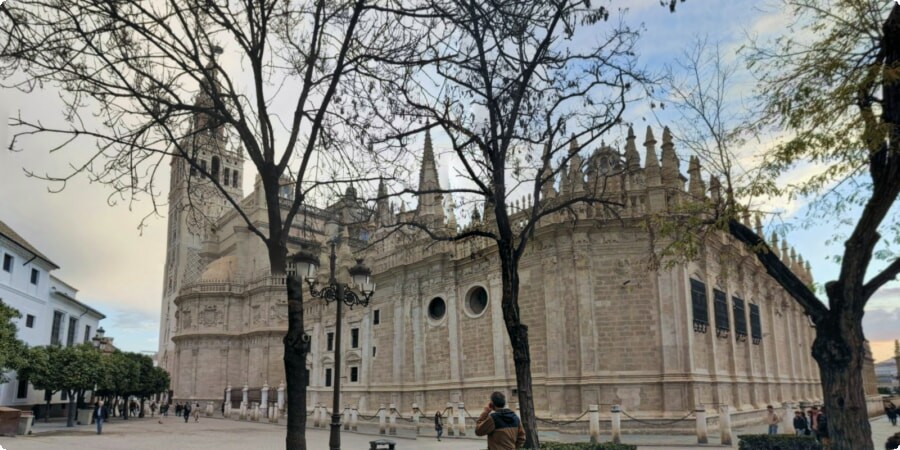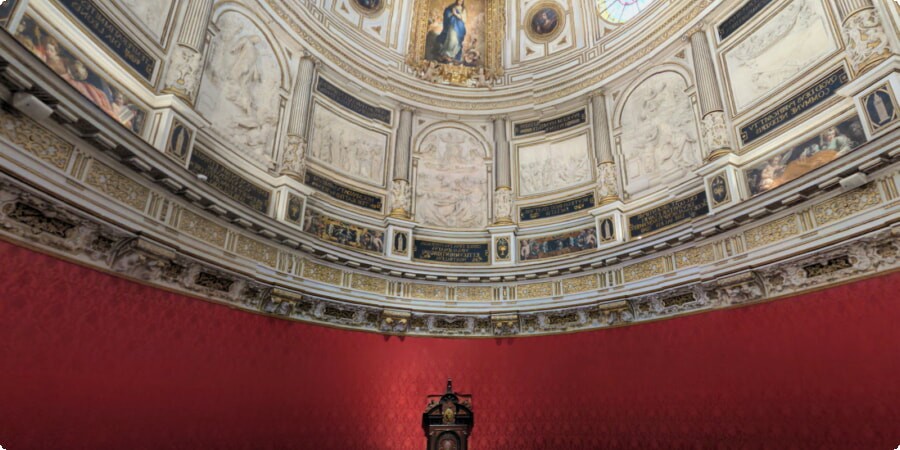La Giralda: The Iconic Bell Tower of Seville
Seville, a city known for its vibrant culture, rich history, and stunning architecture, is home to one of Spain's most iconic landmarks: La Giralda. This magnificent bell tower stands tall, a symbol of Seville's dynamic past and its blend of cultures. Originally constructed as a minaret for the Great Mosque of Seville, La Giralda has transformed over the centuries, now serving as the bell tower for the Seville Cathedral. Its unique blend of Islamic and Gothic architectural styles makes it a must-see for any visitor to the city.
Historical Background
La Giralda's story begins in the late 12th century, during the Almohad dynasty's rule over Seville. It was built as the minaret for the city's Great Mosque, designed to showcase the power and influence of the Islamic rulers. The construction was completed in 1198, and the minaret stood at an impressive height, dominating the city's skyline.
In 1248, the Christian Reconquista brought significant changes to Seville. King Ferdinand III of Castile captured the city, and the mosque was converted into a cathedral. Despite these changes, La Giralda remained intact, symbolizing the city's layered history. Over time, the minaret was transformed into a bell tower, with Renaissance additions in the 16th century, including the iconic Giraldillo weathervane, which was added in 1568. This blend of cultures and eras is what makes La Giralda truly unique.
Architectural Features
La Giralda is an architectural marvel, standing at 104 meters (341 feet) tall. Its design is a testament to the fusion of Islamic and Gothic styles. The lower section, originally the minaret, showcases traditional Almohad architecture with intricate brickwork and horseshoe arches. This part of the tower reflects the influence of the Great Mosque of Kairouan in Tunisia, which served as a model for the design.
The upper section, added during the Renaissance period, introduces Gothic elements. This part includes the belfry, where the bells of Seville Cathedral are housed. The most striking feature of the Renaissance addition is the Giraldillo, a bronze statue that acts as a weather vane. This statue represents Faith and is one of the largest bronze figures of the European Renaissance.

Inside La Giralda, visitors will find a series of ramps instead of stairs. These ramps were designed to allow horse riders to ascend the tower easily, a practical solution during the Almohad period. Climbing these ramps to the top offers a unique experience, culminating in breathtaking panoramic views of Seville and its surroundings.
For those planning to explore Seville and its magnificent landmarks like La Giralda, having a convenient mode of transportation is essential. We recommend booking a car at Barcelona Airport for a seamless travel experience. You can book your car through this link.
In summary, La Giralda's architectural features not only highlight the rich history of Seville but also showcase the blend of cultures that have shaped the city over centuries. Its towering presence and intricate design make it a true symbol of Seville's heritage.
Note: Here are the links as requested:
Google Maps Links:
Cultural Significance
La Giralda holds a special place in the heart of Seville's cultural heritage. More than just an architectural landmark, it is a symbol of the city's rich and diverse history. The tower has witnessed countless historical events, from the days of the Almohad dynasty to the Christian Reconquista and beyond. Its presence in the cityscape is a constant reminder of Seville's past and its enduring spirit.
The bell tower plays a vital role in Seville's religious and civic life. It is an integral part of the Seville Cathedral, the largest Gothic cathedral in the world. The cathedral and La Giralda together form a UNESCO World Heritage Site, underscoring their global cultural significance. During religious festivals like Semana Santa (Holy Week) and Feria de Abril (April Fair), La Giralda becomes a focal point for both locals and visitors, showcasing the deep-rooted traditions of the city.

Climbing La Giralda
One of the most memorable experiences for visitors to Seville is climbing La Giralda. Unlike most towers, La Giralda features a series of ramps instead of stairs. These ramps were originally designed to allow horse riders to ascend the tower, making it easier for the muezzin to call to prayer five times a day during the tower's time as a minaret. Today, these ramps provide a unique and accessible way for visitors to reach the top.
As you ascend, you'll notice the intricate brickwork and architectural details up close. Each turn of the ramp offers a different perspective of the tower's design, blending Islamic and Gothic elements seamlessly. The climb culminates in a viewing platform that offers breathtaking panoramic views of Seville. From this vantage point, you can see the sprawling cityscape, including the winding Guadalquivir River, the lush gardens of the Alcázar, and the bustling streets of the city below.
For those planning to explore Seville and beyond, having a convenient mode of transportation is essential. We recommend booking a car in Spain to enhance your travel experience. You can book your car through this link.
La Giralda and Seville Cathedral
La Giralda is intrinsically linked to the Seville Cathedral, one of the most significant and awe-inspiring religious structures in the world. The cathedral, also known as the Cathedral of Saint Mary of the See, is the largest Gothic cathedral and the third-largest church in the world. Its construction began in 1401 on the site of the former mosque, symbolizing the city's transformation and the blending of cultures.
The Seville Cathedral is renowned for its vast nave, stunning stained glass windows, and numerous chapels adorned with priceless artworks. Among its many treasures is the tomb of Christopher Columbus, a testament to the city's historical importance during the Age of Exploration. The cathedral's grandeur and architectural magnificence are perfectly complemented by La Giralda, which stands as its bell tower.
Visitors to the cathedral can explore its vast interior, marvel at the exquisite craftsmanship, and learn about its historical significance. The connection between the cathedral and La Giralda is a testament to Seville's rich history and cultural heritage, making it an essential stop for any traveler.

Legends and Myths
La Giralda is not only a historical and architectural marvel but also a source of fascinating legends and myths that add to its mystique. One of the most enduring tales is that of the Giraldillo, the bronze statue atop the tower. According to legend, the statue represents Faith, and it is said that the Giraldillo protects the city from harm. Locals believe that as long as the statue stands, Seville will be safeguarded from disasters.
Another intriguing myth involves the tower's construction. It is said that the architect behind La Giralda, Ahmad Ben Baso, was inspired by a dream in which he saw a minaret rising to the heavens. Following this vision, he designed the tower to be as close to perfection as possible. This story highlights the mystical and almost divine inspiration attributed to La Giralda's creation.
These legends, along with many others, contribute to the allure of La Giralda, making it a place steeped in history and mystery. Exploring these stories offers a deeper understanding of the cultural significance and the deep-rooted traditions associated with this iconic landmark.
Visiting La Giralda: Practical Information
When planning a visit to La Giralda, there are a few practical details to keep in mind to ensure a smooth and enjoyable experience. The bell tower is part of the Seville Cathedral complex, and visitors can purchase a combined ticket that grants access to both the cathedral and the tower. It's advisable to buy tickets in advance, especially during peak tourist seasons, to avoid long queues.
La Giralda is open to visitors from Monday to Saturday, with slightly shorter hours on Sundays and public holidays. The best time to visit is in the early morning or late afternoon to avoid the midday crowds and heat. The climb to the top, though relatively easy due to the ramps, can be tiring, so wearing comfortable shoes is recommended.
The viewing platform at the top of La Giralda offers some of the best views of Seville. Don't forget to bring a camera to capture the stunning panoramas. Additionally, the tower is accessible to visitors with disabilities, thanks to the ramp system.

For those looking to explore more of Seville and its surroundings, renting a car is a great option. It provides the flexibility to travel at your own pace and discover hidden gems in the region. You can book a car in Spain through this link, ensuring a convenient and comfortable journey.
La Giralda stands as a testament to Seville's rich and diverse history. Its unique blend of Islamic and Gothic architecture, combined with its cultural and religious significance, makes it a must-see for anyone visiting the city. The legends and myths surrounding the tower add an extra layer of intrigue, drawing visitors from around the world.
Climbing La Giralda offers not only a physical journey but also a journey through time, as each ramp reveals a different aspect of its architectural splendor. The panoramic views from the top provide a breathtaking perspective of Seville, encapsulating the city's beauty and charm.
Whether you're a history buff, an architecture enthusiast, or simply a traveler seeking to experience the heart of Seville, La Giralda promises an unforgettable experience. So, as you plan your visit to this iconic landmark, remember to immerse yourself in its rich history, marvel at its architectural brilliance, and enjoy the stunning views that await at the top.